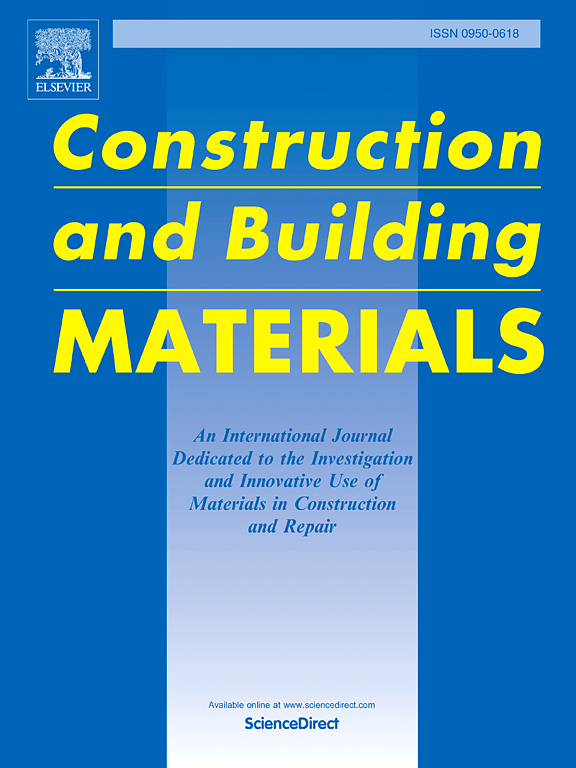A volumetric-deviatoric split constitutive model for the discrete-particle simulation of concrete
IF 8
1区 工程技术
Q1 CONSTRUCTION & BUILDING TECHNOLOGY
引用次数: 0
Abstract
Discrete particle modeling (DPM) is a highly effective method for simulating concrete at the mesoscale. Each DPM model comprises three main components: (1) the method used for spatial tessellation of the sample into rigid particles or cells, (2) the framework for calculating interactions between particles in the elastic range, and (3) the development of constitutive models to describe behavior in the inelastic range. This study presents a new DPM model for the mesoscale modeling of concrete, with particular emphasis on all three key components. The spatial tessellation in the proposed model facilitates the formation of mixed fracture paths, accounting for both the mortar and the interfacial transition zone (ITZ). The elastic relationships are developed to accurately capture the effects of concrete's heterogeneous microstructure on the stress and strain fields. This capability has been validated by comparing the model’s results with those from a finite element meso-model. A new inelastic constitutive model is proposed, which decomposes the material’s behavior into deviatoric and volumetric components, based on the physics of fracture and failure within the concrete microstructure. Additionally, helpful guidelines and suggestions are provided for the initial estimation of each model variable. To validate the model's performance in the inelastic range, uniaxial compression, tensile splitting, and three-point bending samples are fabricated and tested. Comparison of the experimental results with the model’s predictions demonstrates that the model effectively captures failure mechanisms and accurately predicts stress-strain responses under various loading conditions.
混凝土离散颗粒模拟的体积偏差分裂本构模型
离散粒子模型(DPM)是一种非常有效的混凝土中尺度模拟方法。每个DPM模型包括三个主要组成部分:(1)用于将样品空间细分为刚性颗粒或单元的方法,(2)计算弹性范围内颗粒之间相互作用的框架,以及(3)描述非弹性范围内行为的本构模型的发展。本研究提出了一种新的DPM模型,用于混凝土的中尺度建模,特别强调所有三个关键组成部分。该模型中的空间镶嵌有利于混合断裂路径的形成,同时考虑了砂浆和界面过渡区(ITZ)。建立了弹性关系,以准确地捕捉混凝土的非均质微观结构对应力场和应变场的影响。通过将模型的结果与有限元细观模型的结果进行比较,验证了这种能力。提出了一种新的非弹性本构模型,该模型基于混凝土微观结构中断裂和破坏的物理特性,将材料的行为分解为偏量和体积分量。此外,还为每个模型变量的初始估计提供了有用的指导和建议。为了验证模型在非弹性范围内的性能,制作并测试了单轴压缩、拉伸劈裂和三点弯曲样品。试验结果与模型预测结果的对比表明,该模型能有效捕捉破坏机制,准确预测各种加载条件下的应力-应变响应。
本文章由计算机程序翻译,如有差异,请以英文原文为准。
求助全文
约1分钟内获得全文
求助全文
来源期刊

Construction and Building Materials
工程技术-材料科学:综合
CiteScore
13.80
自引率
21.60%
发文量
3632
审稿时长
82 days
期刊介绍:
Construction and Building Materials offers an international platform for sharing innovative and original research and development in the realm of construction and building materials, along with their practical applications in new projects and repair practices. The journal publishes a diverse array of pioneering research and application papers, detailing laboratory investigations and, to a limited extent, numerical analyses or reports on full-scale projects. Multi-part papers are discouraged.
Additionally, Construction and Building Materials features comprehensive case studies and insightful review articles that contribute to new insights in the field. Our focus is on papers related to construction materials, excluding those on structural engineering, geotechnics, and unbound highway layers. Covered materials and technologies encompass cement, concrete reinforcement, bricks and mortars, additives, corrosion technology, ceramics, timber, steel, polymers, glass fibers, recycled materials, bamboo, rammed earth, non-conventional building materials, bituminous materials, and applications in railway materials.
 求助内容:
求助内容: 应助结果提醒方式:
应助结果提醒方式:


